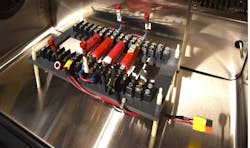As closed “black box” components, batteries are challenging energy-storage systems to fully assess. It’s obviously easy to measure their terminal voltage and input/output current, and to estimate their internal temperature based on external readings and appropriate thermal models. However, measuring their impedance is difficult, especially when the battery is in use. Yet that last factor is needed to fully judge their health and condition in active use or during a maintenance cycle.
To address this issue, the Idaho National Laboratory (INL) has developed an impedance measurement box (IMB) that directly addresses the in-use characterization of this parameter (Fig. 1). (INL is a leading government laboratory in the U.S. for research, development, demonstration, and deployment related to nuclear and other types of energy.) The project was developed in conjunction with Montana Tech, Motloch Consulting, and Qualtech Systems Inc., with support from the DoE Office of Energy Efficiency and Renewable Energy’s Vehicle Technologies Office.
1. The “impedance measurement box” developed at Idaho National Laboratory applies a signal consisting of a set of sine waves to the battery under evaluation. The resultant response is used to analyze its impedance while in use. (Source: INL)
In the IMB system, an input signal composed of a wideband set of to about 25 to 30 sine waves is injected into the battery. Typical frequencies are between 0.1 and 1650 Hz (the typical limit used for lithium-ion batteries), but can go higher depending on the battery specifics and test objectives. The limit of 1650 is mainly what is used for Li-ion battery technologies.
The battery’s response is captured and processed by a set of algorithms to provide results that characterize a single cell or cluster of cells (Fig. 2). Unlike existing test techniques for impedance measurement, which require expensive laboratory equipment and take as long as 10 minutes, the IMB procedure takes about 10 to 15 seconds to directly measure the wideband impedance spectrum during battery operation, and with no significant impact on service life.
2. The IMB can acquire and provide multipoint impedance spectra in as little as 10 seconds, delivering a detailed picture of a battery’s condition and health. (Source: INL)
Use of this near-real-time, in-use battery IMB should lead to development of energy-storage and management systems with more-accurate indications of pending failures, and enable smarter management for extended battery life. Further, by keeping careful track of the safety and performance of batteries as they age in actual use, manufacturers and users can make more informed decisions about the battery’s state of health and likely life.
The IMB is not just a laboratory tool—in fact, it is now at the center of a licensing agreement between INL and Dynexus Technology, a Colorado company that seeks to commercialize the device for use in applications ranging from backup-battery-power systems to plug-in electric vehicles (PEVs). The latest version of the IMB is a third-generation unit that can assess a 50-V system, needed for testing of large-scale battery assemblies that contain larger numbers of cells.
References:
Battery University, “BU-902: How to Measure Internal Resistance”
Tektronix, “Measuring battery internal resistance is easy!”
Battcon 2017 Stationary Battery Conference and Trade Show, “The Virtues of Impedance Testing of Batteries”
About the Author

Bill Schweber
Contributing Editor
Bill Schweber is an electronics engineer who has written three textbooks on electronic communications systems, as well as hundreds of technical articles, opinion columns, and product features. In past roles, he worked as a technical website manager for multiple topic-specific sites for EE Times, as well as both the Executive Editor and Analog Editor at EDN.
At Analog Devices Inc., Bill was in marketing communications (public relations). As a result, he has been on both sides of the technical PR function, presenting company products, stories, and messages to the media and also as the recipient of these.
Prior to the MarCom role at Analog, Bill was associate editor of their respected technical journal and worked in their product marketing and applications engineering groups. Before those roles, he was at Instron Corp., doing hands-on analog- and power-circuit design and systems integration for materials-testing machine controls.
Bill has an MSEE (Univ. of Mass) and BSEE (Columbia Univ.), is a Registered Professional Engineer, and holds an Advanced Class amateur radio license. He has also planned, written, and presented online courses on a variety of engineering topics, including MOSFET basics, ADC selection, and driving LEDs.



